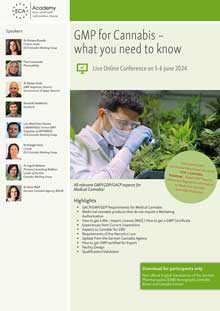FDA Issues Draft Guidance for Cannabis

Recommendation
5/6 June 2024
All relevant GMP/GDP/GACP aspects for Medical Cannabis
The U.S. Food and Drug Administration (FDA) issued a new guideline on quality considerations for clinical research with cannabis and cannabis-derived compounds. The draft guidance covers
- sources of cannabis for clinical research,
- information on quality considerations, and
- recommendations regarding calculating tetrahydrocannabinol (THC) levels.
The guidance also introduces key FDA regulatory concepts to stakeholders who may be less familiar with the FDA and the FDA's authorities than other drug developers. The agency emphasizes that the same regulatory standards apply as for any other botanical raw material, botanical drug substance, or botanical drug product.
Sources of Cannabis
Activities related to growing and manufacturing of cannabis for use as an IMP (investigational medicinal product) must comply with CSA (Controlled Substances Act) and DEA (Drug Enforcement Administration) requirements if the cannabis exceeds the limit of 0.3% Δ-9 THC by dry weight. The 2018 Farm Bill changed how cannabis is treated under the CSA. The bill removed hemp (< 0.3% Δ-9 THC) from the definition of marihuana. Currently,
- the NIDA DSP (National Institute on Drug Abuse / Drug Supply Program) is the only domestic federally legal source of cannabis over the 0.3% Δ-9 THC limit for clinical research,
- cannabis below the 0.3% Δ-9 THC limit may be used for clinical research.
Quality Considerations
Sponsors have to submit information regarding the identity, quality, purity, and potency or strength of the IMP. General considerations and recommendations for botanical drugs are provided in FDA´s guidance for industry Botanical Drug Development. The agency states that published literature in place of a full toxicology program to support development of a botanical drug product will not be sufficient.
In addition, the USP Cannabis Expert Panel has recently published an article on the quality requirements for medical cannabis. The article describes the appropriate use of USP General Chapters related to chromatographic methods and controls for contaminants.
Devices and Packaging
If a device is to be used in combination with the drug (e.g., when the product is delivered via an inhaler), the product is considered to be a combination product and must comply with the cGMP requirements in 21 CFR part 4 including the requirements for design controls.
Sponsors should consider selection of a packaging system carefully including adequate characterization and safety assessment of extractables and leachables (E&Ls). The evaluation of E&Ls should be consistent with USP General Chapters <1663> and <1664>, FDA´s Guidance for industry Container Closure Systems for Packaging Human Drugs and Biologics and the applicable dosage form-specific guidances.
Percent of Δ-9 THC Calculation
The calculation of Δ-9 THC in proposed IMPs should be conducted early in the development phase to gain insight into the potential control status of the product. Sponsors should refer to the U.S. Department of Agriculture (USDA) interim final rule, "Establishment of a Domestic Hemp Production Program" for sampling and testing methods for evaluating the level of Δ-9 THC. In addition, FDA´s draft guidance provides detailed recommendations regarding the calculation of Δ-9 THC percentage
- for a solution (i.e. intermediate, in-process material, or final drug product), and
- for a solid oral dosage form (e.g., tablet or capsule).
The calculation of Δ-9 THC is based on the composition of the formulation with the amount of water removed, including any water that may be contained in excipients. However, for "either solutions or solids, use of the proposed or established specifications for the upper limit of water content for excipients that contain water, as opposed to a measured result from a sample, may be acceptable and would be a matter for review".
Furthermore, applicants should provide the following information:
- quantitative data, such as a certificate of analysis (CoA) from a laboratory described in the USDA interim final rule,
- detailed descriptions of analytical methods (for phase 2 - 3 studies and marketing applications),
- calculations for the reporting levels of Δ-9 THC based on rounding rules provided in USP´s General Notices and Requirements.
Shipping
Manufacturing processes may generate materials, such as intermediates, that exceed the 0.3% Δ-9 THC by dry weight threshold even if the source material or finished product does not exceed the threshold. "Sponsors, investigators, and applicants who anticipate generating such intermediates that may be shipped between manufacturing sites should contact DEA for recommendations", the agency states.
More information is provided in FDA´s new draft guideline entitled "Cannabis and Cannabis-Derived Compounds: Quality Considerations for Clinical Research".
Related GMP News
GMP Conferences by Topics
- General Quality Assurance and GMP Compliance Topics
- Hygiene
- General Microbiology Topics
- Regulatory Affairs
- Development
- General Analytics Topics
- Good Distribution Practice
- Sterile Manufacturing
- Computer Validation
- General Qualification/Validation Topics
- General Engineering Topics
- APIs/Excipients
- GMP Basic Training Courses
- Medical Devices and Combination Products
- Packaging and Packaging Material
- Data Integrity
- Qualified Person (QP)
- GMP Auditing
- Documentation
- Cleaning Validation
- General IT Compliance Topics
- Impurities
- OOS / OOE / OOT
- Material Testing
- Validation of Analytical Methods
- Analytical Instrument Qualification
- Stability Testing
- Microbiological Testing
- Technology
- General Manufacturing Topics
- Solid Dosage Forms/Semi-Solid Dosage Forms
- Biotechnology/Blood/ATMP
- Herbal Drug Products/Cannabis/Radiopharmaceuticals
- Others




